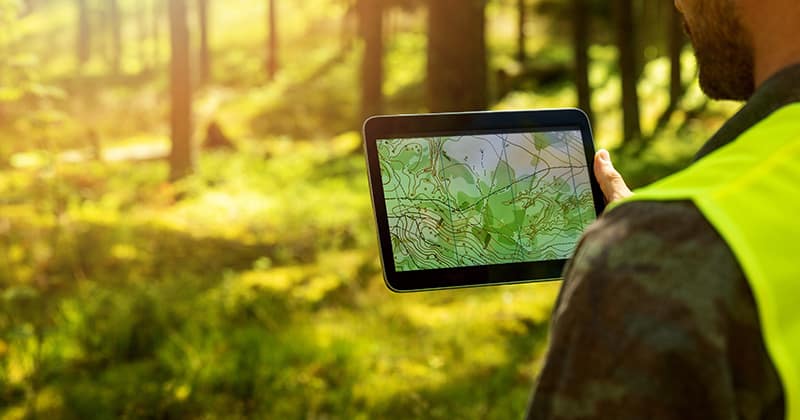Landscape design CAD (Computer-Aided Design) software is an essential tool for landscapers who want to bring their ideas to life. But if you’re new to CAD, the learning curve can be a bit intimidating.
While CAD software can be overwhelming, it’s worth the time and effort. Not only will it expand your skill set, but it can also open new opportunities to elevate your work.
Fortunately, there are many resources available to help you get started. In this article, we’ll talk about the benefits of landscape design, as well as give you some tips and advice on how to go about learning to use it.
RELATED ARTICLE: How to Become an Expert Landscape Designer
Why Use Landscape Design CAD software?

Are you tired of manually designing landscaping plans? Have you ever spent hours sketching out ideas, only to find yourself starting over from scratch?
While it may seem overwhelming at first, learning how to use CAD software is a valuable investment that can save you time, money, and headaches.
Let’s look at some of the key advantages of using a CAD solution specifically tailored toward landscape professionals.
Improved Efficiency
With CAD software, the days of working with paper and pencil are long gone. CAD software is faster, more accurate, and can create multiple design options within a short period of time.
Moreover, with CAD rendering and visualization, changes and modifications to the design can be made without having to redraw a new design. This saves you time and money, allowing you to focus on other aspects of the business.
Better Visualization
CAD software allows you to create 3D models that help bring your designs to life. The 3D modeling function helps you sell your ideas by giving the client a better view of how the final product will look.
Not only does this feature help clients visualize the outcome, but it also makes the presentation polished and impressive.
Enhanced Accuracy and Precision
When it comes to designing a landscape project, every detail matters. And with CAD software, you can easily perfect every detail, as it allows you to input precise dimensions, sizes, and plans.
Not only does this enhance the accuracy of the design, but it boosts the confidence of clients as they can see clearly what their final design will look like.
RELATED ARTICLE: The Perfect Landscape Design Experience and How to Achieve It
Reduced Errors
Errors are costly; they result in time delays and affect the outcome of a project. With CAD software, the risk of human errors is greatly reduced. It eliminates the possibility of measurement and calculation errors common with manual methods.
Better Collaboration
Collaboration between team members is made easier with CAD software. Team members can work on a single project simultaneously, minimizing the time taken for collaboration.
This saves time and ensures that everyone involved in the project is on the same page, improving communication and creating a better outcome for the client.
Increased Customer Satisfaction
Clients expect efficient, hassle-free services from landscape businesses. CAD software allows you to create highly detailed, accurate, and professional presentations for clients in less time.
This results in enhanced customer satisfaction and increases your chances of securing repeat business or referrals.
RELATED ARTICLE: Challenges of Learning 3D Landscape Design Software
Tips for learning landscape design CAD software

Learning CAD software for landscape design may seem daunting at first. But with the right resources and mindset, it can be a rewarding and enjoyable experience.
By following our CAD training tips, you can quickly become a pro at creating accurate and realistic visualizations that take your business to the next level.
Do Your Research
First things first – you need to choose the right software. There are a few different programs on the market that are designed specifically for landscape design. Some popular choices are DynaScape, SketchUp, AutoCAD, and Vectorworks.
Do some research into each program. Check out their features and user reviews to determine which one is best for your needs. Keep in mind that some software may have a steeper learning curve than others, so choose wisely.
Watch Tutorials and Online Courses
Once you’ve chosen your software, it’s time to start learning. While you could teach yourself how to use the software through trial and error, you’ll save yourself a lot of time and frustration by taking a course or watching tutorials.
There are countless tutorials available online that can help you learn CAD software. Many software companies offer training courses. There are also many online tutorials available on sites such as YouTube, Udemy, and Skillshare.
Attend Workshops or Classes
If you prefer to learn in a more structured environment, consider signing up for a workshop or course. Many community colleges, universities, and continuing education programs offer courses on CAD software.
You can also find workshops or classes through professional organizations such as the Association of Professional Landscape Designers.
These courses often provide the opportunity to learn in a group setting, and you will have access to professionals who can answer your questions.
Join a Community or Forum
Joining a community, such as an online forum, can be incredibly helpful when you’re trying to learn new skills. There are countless online communities that are focused on landscape design CAD software.
You’ll be able to connect with other people who are trying to learn the same things you are. These communities provide you the opportunity to ask questions, get feedback, and learn tips and tricks.
Practice, Practice, Practice
Now that you have the basics down, it’s time to start practicing regularly. Start with simple projects and work your way up to more complex designs.
Start with small projects and work your way up to larger ones. Create mock designs and test out different features of the software. Don’t be afraid to experiment and make mistakes.
The best way to learn any software program is to use it frequently. It can be helpful to save your work at different stages to reference your progress. The more you use the software, the more comfortable you will become with it.
Stay up to date
Learning a new skill takes time and patience, but it’s essential to keep updating your skills. Keep an eye out for new software updates and features. and always be on the lookout for new ideas and techniques.
Joining online forums or attending trade shows can also help you stay up-to-date on the latest industry trends.
RELATED ARTICLE: How 3D Landscape Rendering Software Transports Landscape Design Software
Jump Start Your Landscape Design Software Training

Jump start your landscape design software training with these next steps:
- Research the available software options – Utilize online resources such as knowledge centers, webinars, and user reviews to decide which CAD software will be the best fit.
- Take a test drive – Contact various CAD software providers for a demo of their products to learn more about their tools and features.
- Make a connection – Find an online or in-person community of landscape designers who use CAD software who can provide advice and share ideas.
About the Author
As the President of both Fieldpoint and DynaScape, Brad is focused on growth. His leadership style is all about enabling and uniting those he works with. On the weekends, he loves to tackle landscaping and construction projects himself.